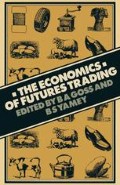Abstract
One of the recurring arguments made against futures markets is that, by encouraging or facilitating speculation, they give rise to price instability. This argument, in various versions, has been made throughout past Congressional hearings on onion and potato futures. The theoretical literature available on the subject of futures trading and price stability is rather scanty and inconclusive. Most of the evidence has been gathered on onion and potato prices. It suggests that: a) the seasonal price range is lower with a futures market because of speculative support at harvest time; b) sharp adjustments at the end of a marketing season are diminished under futures trading because they have been better anticipated; and c) year-to-year price fluctuations are reduced under futures trading because of the existence of the futures market as a reliable guide to production planning. See Roger Gray, and Holbrook Working (1958, 1960, 1963).
Access this chapter
Tax calculation will be finalised at checkout
Purchases are for personal use only
Preview
Unable to display preview. Download preview PDF.
References
P. H. Cootner ed. The Random Character of Stock Market Prices, Cambridge, Mass. 1964.
R. Gray, ‘Onions Revisited,’ Journal of Farm Economics, vol. 45, 1963.
H. S. Houthakker, ‘Systematic and Random Elements in Short-Term Price Movements,’ American Economic Review, vol. 51, 1961.
A. Larson, ‘Measurement of a Random-Process in Futures Prices,’ Food Research Institute Studies, vol. 1, 1960.
G. Tintner, The Variate Difference Method, Bloomington, 1940.
H. Working‘A Random-Difference Series for Use in the Analysis of Time-Series,’ Journal of American Statistical Association, vol. 29, 1934.
H. Working, ‘A Theory of Anticipatory Prices,’ American Economic Review, Proceedings, vol. 48, 1958.
H. Working‘Price Effects of Futures Trading,’ Food Research Institute Studies, vol. 1 1960.
H. Working ‘New Concepts Concerning Futures Markets and Prices,’ American Economic Review vol. 51, 1961.
H. Working‘Futures Markets Under Reserved Attack,’ Food Research Institute Studies vol. 4, 1963.
U.S. Congress. House Subcommittee on Agriculture. ‘Prohibit Trading in Irish Potato Futures on Commodity Exchange,’ Hearings on H.R. 904, 88th Cong., April 8–10, 1963.
U.S. Congress. Senate. Hearings Before a Subcommittee of the Committee on Agriculture and Forestry, 85th Cong., 1st sess., Aug. 12, 1957.
U.S. Congress. Senate. Hearings Before the Committee on Agriculture and Forestry, 85th Congress, 2nd sess., Mar. 22–26, 1958.
Copyright information
© 1976 Palgrave Macmillan, a division of Macmillan Publishers Limited
About this chapter
Cite this chapter
Powers, M.J. (1976). Does Futures Trading Reduce Price Fluctuations in the Cash Markets?. In: The Economics of Futures Trading. Palgrave Macmillan, London. https://doi.org/10.1007/978-1-349-02693-7_14
Download citation
DOI: https://doi.org/10.1007/978-1-349-02693-7_14
Publisher Name: Palgrave Macmillan, London
Print ISBN: 978-1-349-02695-1
Online ISBN: 978-1-349-02693-7
eBook Packages: Palgrave Economics & Finance CollectionEconomics and Finance (R0)

